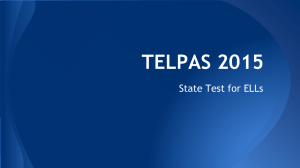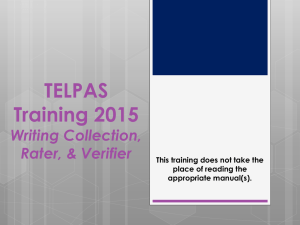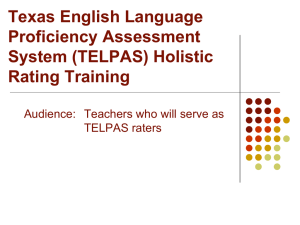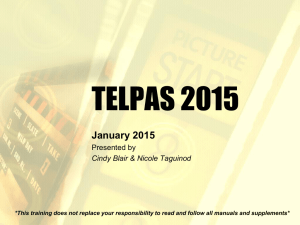TELPAS 2013 - Big Spring ISD
advertisement
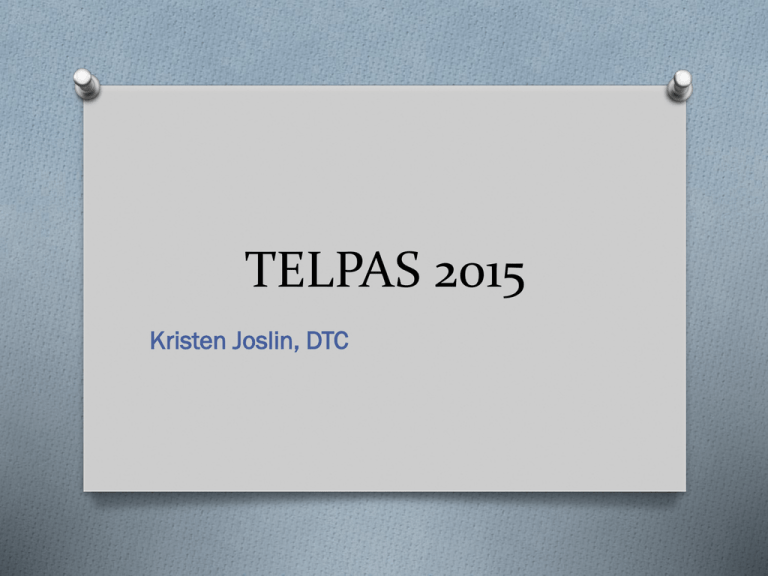
TELPAS 2015 Kristen Joslin, DTC This training does not replace your responsibility to read and follow all manuals and supplements. Manuals to consider: 2015 DCCM Test Security Supplement TELPAS: Rater Manual TELPAS: Reading Test Administrator Manual General Information • Grades K-12 LEP students including parent denials • Components ▫ K-1 reading, writing, listening and speaking ▫ 2-12 writing, listening, speaking and on-line reading test • Test Dates ▫ Writing Collection: Feb 16 - March 26 ▫ Reading online: March 16 - April 8 (should not have “absent” students) ▫ Late arrivals – _________ or later, reading test only Who Takes TELPAS All ELLs in grades K–12, including those whose parents decline bilingual/ESL program services, are assessed annually. In extremely rare cases, an ELL receiving special education services may be exempted from particular TELPAS domain(s) by the ARD committee TEA 5 in conjunction with the LPAC. LEP & SpEd Students • The ARD and LPAC committee meet TOGETHER to determine domain by domain for rating and testing students. • Documented on “ESL/Bilingual & Special Education Test Assignment and Accommodations” Form • Deadline is February 21, 2014 NO BLANKET EXEMPTIONS. Years in U.S. Schools O Years in US Schools is often confusing because pre-K and Kinder are not included in the count. It starts with grade 1 O Keep in mind the 60 day rule O Years in U.S. schools are important because they are used to determine accountability performance requirements for AYP and the Progress Measurement O For more information refer to the LPAC Manual TEA Dates Date Activity 1/12 Assembling and Verifying Grades 2–12 Writing Collections Course available 1/23 End date for district coordinator training—all TELPAS components 1/26 Online basic training courses for new K–1 and 2–12 raters available 1/26 Supplemental support provider recorded Web-based training available 2/6 End date for campus coordinator training—holistically assessed components 2/16 End date for training raters and verifiers on administration procedures 2/16 Earliest eligibility date for TELPAS writing samples 2/16 Calibration window opens for new and returning raters—first 2 sets 2/25 Third and final calibration set available 3/16–4/8 TELPAS assessment window 4/09– 4/10 TELPAS data verification window 4 Test Security and Confidentiality O Protect the contents of all online assessment and student performance (ratings and writing samples) documentation O Train and sign oath prior to handling testing materials. O No viewing, discussing, providing answers to secure testing materials (paper or on-line) O This also includes sharing answers to the raters training in Tx Training Center. Campus Test Coordinator Responsibilities TELPAS Campus Coordinator Responsibilities • Read all manuals • You will act as the writing collection verifier • Enter/verify student information in the online system • Ensure computer systems have been checked before testing ▫ Contact Jamie Scott if you have computer issues Campus Coordinator Responsibilities • Ensure that all eligible students are identified and tested (Howard) • Oversee the implementation of validity and reliability • You and your principal are responsible for test security on your campus • Supervise and actively monitor testing • Be the campus contact for all questions about testing • Report testing irregularities and security violations immediately • Campus documentation will go into the notebook and returned by May 1. Things to Know About TELPAS Rater Training and Administration Procedures TEA 13 Overview of the Rating Process O Districts identify ELLs in grades K–12 and designate raters to assess students O Test administration procedures and holistic rating training conducted to prepare grades K– 12 raters to assess English language proficiency consistent with the holistic scoring rubrics, the Proficiency Level Descriptors (PLDs) O Raters gather writing samples for ELLs in grades 2–12 to include in each student’s writing collection O Raters use PLDs to assign students a rating in each language domain assessed 14 Rater Credentials Each teacher selected to rate an ELL must 1) have the student in class 2) be knowledgeable about the student’s ability to use English in instructional and informal settings 3) hold valid education credentials such as a teacher certificate or permit 4) be appropriately trained, as required by TEA TEA 15 TELPAS Rater Responsibilities O A student’s TELPAS rater is the teacher designated by the district as the official rater of the student’s English language proficiency. O The student’s rater must rate the student in all domains for which the student is eligible. A student is not permitted to have one rater for some domains and another rater for other domains. TEA 16 Collaboration with Others In determining the proficiency ratings of their assigned students, raters are highly encouraged to collaborate with other teachers and school personnel who have knowledge of the students’ English proficiency. TEA 17 New and Returning Rater Definitions for K–1 and 2–12 •A returning rater who has not completed the basic online training within the past three years will be required to complete training as a new rater. 18 TEA Two Types of Training O Online basic training course This course is for new raters. It provides instruction on using the PLD rubrics and gives raters practice rating students in each language domain. There are separate courses for K–1 and 2–12. O Online calibration This is for all raters. Raters use the PLDs to rate students in each language domain. Raters have three opportunities to calibrate on assigned grade cluster. 19 TEA Fall ELPS-TELPAS Foundational (Awareness) Training For teachers who will be trained as new TELPAS raters in the spring if they lack this foundation Spring TELPAS Administration Procedures Training As a key part of this training, information from the TELPAS Manual for Raters and Test Administrators is reviewed to prepare raters to proceed with online holistic rating training New Raters Returning Raters Online Basic Training Course Online Calibration (Sets 1 and 2*) Online Calibration (Sets 1 and 2*) If not calibrated: Supplemental Holistic Rating Training *Set 2 required only if not successful on Set 1 Final Online Calibration (Set 3) When and where do raters take the online training? O I will notify raters of which training they will be required to attend by Feb. 30. O March 2 or 3: New Raters (all day) O March 4 or 5: Returning Raters (half day) O If calibration is not completed, raters may do so during school hours, at home after school, or on weekends. O The online training system allows raters to access the training from any computer that meets the minimum system requirements. 21 TEA Why is calibration necessary? O Calibration helps ensure that raters have adequate training, including ample practice and feedback, before they assess their students in the spring. O Calibration ensures that raters clear their heads and consider only the elements of student performance included in the PLDs. O Calibration supports assessment validity and reliability and is an important part of holistically scored assessment processes. 22 TEA Is calibration a test? No, it is a training method that ensures that raters have enough guidance, practice, and support to assess students consistently and accurately. Preparing for Calibration Sets O New raters must complete the online basic training course before beginning calibration. O Returning raters have the option to review the online basic training course (which includes rating activities) before beginning calibration. 23 TEA Other Things to Know About Calibration O Raters affirm online that they will keep the contents of the calibration sets secure and confidential. O Calibration activities are taken from a bank and randomized. Trainees will rate different sets of students. O Raters can work at their own pace, go back and review students, and change ratings as they work. 24 TEA Other Things to Know About Calibration O Raters can exit and return later to finish. They click a “submit” button when they are finished with a set. O After completing a calibration set, raters immediately see results. Results show the rating assigned by the rater and the correct rating. O Raters see annotations explaining the ratings. Raters should use the annotations to go back and review any incorrectly rated students. 25 TEA Will raters be able to refer to any resources during calibration activities? Yes, raters should use their rating rubrics (PLDs) and refer to, as needed, information from the: O online basic training course O holistic rating PowerPoints produced by TEA O TELPAS Manual for Raters and Test Administrators O Educator Guide to TELPAS 26 TEA Proficiency Level Descriptors (PLDs) The PLDs are the rubrics teachers use to determine students’ English language proficiency for ongoing formative assessment and the spring TELPAS administration. Originally developed for TELPAS, the PLDs were incorporated into the Texas English language proficiency standards (ELPS) in the 2007–2008 school year to reinforce their use in instruction. 27 TEA 6 Sets of PLDs O Listening Grades K–12 O Speaking Grades K–12 O Reading Grades K–1 Grades 2–12 (online) O Writing Grades K–1 Grades 2–12 (writing collection) 28 TEA Key Features of Each Proficiency Level O Beginning O Little or no English ability O Intermediate O Limited ability, simple language structures, high-frequency vocabulary, routine contexts O Advanced O Grade appropriate, with second language acquisition support O Advanced High O Grade appropriate, with minimal second language acquisition support 29 TEA How many students must be rated successfully? To be successful, raters need to rate students in their assigned grade cluster with at least 70% accuracy. 30 TEA Supplemental Holistic Rating Training O Raters not successful after sets 1 and 2 must receive supplemental training. O After the rater has received supplemental training, he or she will be able to access the third and final calibration set. 31 TEA Recap of Calibration Process O There are 3 sets of 10 students. O Raters who calibrate on set 1 are done. O Raters who don’t calibrate on set 1 go on to set 2. Raters who calibrate on set 2 are done. O Raters who don’t calibrate on set 2 receive supplemental training. O Raters attempt third and final calibration set. O Raters who calibrate on set 3 are done. 23 TEA What happens if a rater is unsuccessful in calibrating? Two outcomes are possible for individuals who complete the calibration activities but are not successful: O The district may choose not to assign the individual to be a TELPAS rater. O If the individual is needed to serve as a rater, the district must implement rater support procedures to ensure that the rater’s students are evaluated consistent with the rating rubrics. Individuals are not authorized to serve as raters unless they complete the required training components. TEA Rating Roster An Additional Rater is required if the Rater did not pass the Calibration set with a 70% or higher after the 3rd attempt There must be teacher collaboration on ratings as part of the Validity & Reliability process TELPAS Validity and Reliability Procedures O TEA mandated district procedures O For all language domains – grades K-12: O Raters will collaborate with other teachers of the students in determining the student’s rating. One collaborator will initial the TELPAS Rating roster for each child O For writing – grades 2-12: O All writing collections will be approved/verified before raters may begin the rating process. Course and Calibration Certificates O Raters who take the basic training course get a certificate from the online TxTrainingCenter after completing the course components. O Raters will receive a certificate of successful calibration when they calibrate. O They will be given direction to print them off and turn into you. O All certificates will go in the TELPAS Documentation notebook 36 TEA Assembling and Verifying Writing Collections O 2 – 12 O Five writing samples O At least one narrative about a past event O At least two academic writing samples from math, science, or social studies. O All samples must have student’s full name and date accomplished on them O Only writing samples on or after February 16th may be used Assembling and Verifying Writing Collections O May be a “clean” copy from work by the student to include a journal O No corrections by teacher or peers O May be typed but spelling and grammar checker must be off O The writing collection cover sheet and verification from Appendix A must be completed and attached on top of the samples for each student What Not to Be Include in Collections • Copied from a textbook, lesson, or other written • • • • • sources. Papers done with heavy use of a dictionaries or thesaurus Papers with teacher’s, peers, or parents corrections Written primarily in another language than English Worksheets or Q and A writing assignments Brief, incomplete, or rushed papers Verifier Responsibilities Attend training on administrative procedures Obtain access to Texas Training Center Complete online training “Assembling and Verifying Writing Collections” Print Certificate of Completion and put in notebook Verify student writing collections in accordance with the checklist Sign Oath Verifier cannot be a TELPAS Rater Online Training- Verifiers Verifiers need self register for an account in the Texas Training Center https://texas.pearson.desire2learn.com Site Code: telpas2015 Returning users that have forgotten their login information click on the “Login Help” link New Users click on the “Self Registration” link Page 57 in Rater Manual Online Training- Verifiers Verifiers need to self register for an account in the Texas Training Center https://texas.pearson.desire2learn.com Site Code: telpas2015 Click on TELPAS 2015 under the “My Texas TrainingCenter Program” header then: Verifying the Writing Collection Verifiers ensure that the writing collections meet all of the criteria based on the Verification Checklist by initialing each item (checklist is on the back of the Writing Collection Cover Sheet) page 54 of Rater Manual Verifiers sign the bottom of checklist Writing Collections are secure materials TELPAS Reading O TELPAS reading is conducted as an online only assessment O Administered to all LEP students in grades 2-12 O Since it is online, there are no test booklets or answer documents to handle or process TELPAS Reading Accommodations O Refer to on-line accommodations O It is possible that a required accommodation is not available with online testing. In those cases, we will have to request approval from TEA to give a paper version of the test and order the materials. This is not a last minute process. Plan Ahead!! TELPAS Reading Make-Ups O All students must be assessed within the assessment window O If a student is absent the day you have them scheduled to take TELPAS reading then move them to another session that will test later within the TELPAS assessment window O The TEA expectation is that we test every eligible student within the TELPAS assessment window Tutorials • All students are required to take the tutorial prior to • • • • the day of the test. May take as many times as campus wants. Tutorials are about how to use the computer not necessary the type of test questions Keep a student roster for documentation of the tutorials for the TELPAS Documentation notebook http://www.texasassessment.com/TELPAS/tutorials/ Student Tutorial Administration Directions are available at the bottom DOMAINS LEVEL Listening Beginning Speaking Intermediate Reading Advanced Writing Advanced High O If a student is not rated in one or more domains, select one of the following: E = Extenuating Circumstances X = ARD Decision Entering Ratings • I will responsible for creating and managing Rating Entry Groups. • You will be responsible for entering your raters ratings before the verification window. (noted on the calendar) Entering Ratings O K-1 need to be grouped in a Rating Entry Groups so that student ratings can be entered online. Ratings entered for K-1 include listening, speaking, reading, and writing. O 2-12 can be sorted one way for entering ratings and for reading another way. Ratings for students will be entered for listening, speaking and writing. DATES • On-line reading assessment: March 16 – April 8 • Schedule of schools ▫ HS: ▫ JH: ▫ BSI: ▫ Moss: ▫ Goliad: ▫ Marcy: ▫ Washington: Prepare for TELPAS Reading GR 2-12 • Links to the web-based tutorials available for each grade cluster on Testing Department website. • No downloading or installation is necessary to access and use the tutorials. • With NO sample items in the actual test, make sure to schedule lab time for students to practice with the tutorial. TELPAS Reading O Students in grades 2-12 are assessed through an online multiple-choice test. Grade Clusters 2 3 4-5 6-7 8-9 10-12 Testing Accommodations O Refer to the TELPAS Reading manual (page 8-9) O Not Permitted: O Reading assistance O Reference materials O Test questions or selections translated O Test questions, answer choices, or selections clarified Reading Test Administrator • Reading Test Administrator is the person who, during the test session, guides students through opening their tests, and begins the test itself. • The test administrator is responsible for maintaining test security and for managing breaks/interruptions. • Reading Test Administrator: ▫ Rater ▫ Certified Teacher Computer Check • Jamie will complete TestNav System Check O If on test day, computers FAIL to launch TestNav: O Contact me Ext. 1047 Cell 940-389-5979 O Campus Name O Room Number Materials Needed for Testing O Copy of manual O Seating Chart O Test Session Roster O Student Authorization Letters (secure documents) O Scratch paper for each student O Pencils for each student TELPAS Reading Manual p: 19 Student Authorization Letters • Each student must have a Student Authorization Letter • • • • • in order to log in to a test. The authorization letter contains the web address that students enter to access TestNav with the unique username and test coded needed. A password is not required to log into a test, so the password field will be blank. You can print these letters any time before students in the session are to log in to the test. The letters must be kept in a secure location until the test is administered. Click the GET AUTHORIZATION button on the Session Roster screen to access. Place in the TELPAS Documentation notebook TELPAS Reading Manual p: 18 Testing Environment • At least one trained administrator for every 30 • • • • students. Computer monitors prepared to discourage students from viewing each other’s monitor. Bulletin boards and instructional displays that might aid students during testing must be removed or covered. The testing room should be quiet, well lighted, comfortable, with enough space to work. “Testing-Do Not Disturb” sign posted outside the testing room. Testing Procedures • Seating chart is completed to include students’ names, locations, • • • • • • • • • and test administrator information. The test is untimed. Work stations are cleared of books and other materials. Student MUST remain seated and no conversing while testing. Each student must be allowed to work at his or her individual speed. NO reference materials are allowed. Allowed to use scratch paper, but all scratch paper must be destroyed after test administration. Active monitoring during the test session. After students have finished, they may read or leave the room. BEFORE a student who has finished testing leaves the room, test administrator must ensure the student’s test is in “Submitted” status. TELPAS Reading Manual p: 20-21 Other Testing Issues O Answering student questions O Computer monitor glare O Student breaks O Lunch O Cell phones O Emergencies O Changing rooms TELPAS Manual p: 21-22 Starting a Test A test session MUST be started before any students can log in to TestNav and begin the test. A test session does not start until the TEST ADMINISTRATOR clicks the Start button on the Session Details screen, regardless of the scheduled start time and date. TELPAS Reading Manual p: 23 Launching the Test • Before students in GR 2-5 can begin the test, TestNav must be launched on each student’s computer, and the login ID and test code found on each Student Authorization Letter MUST be entered by the Test Administrator. • Do NOT begin a test for an ABSENT student. TELPAS Reading Manual p: 31 Launching the Test O Test administrators guide students through the login process for GR 6-12 TELPAS Reading Manual p: 37 Monitoring Sessions • Session Details screen • Periodically click Refresh • Real-time test status TELPAS Reading Manual p: 24-25 STATUS: • Ready • Active • Exited • Resumed • Resumed-Upload • Completed • Marked Complete Resume O If a student exits TestNav--O Return to Session Details and select the checkbox next to that student’s name. O A resume checkbox is only available if that student’s status is Started, Exited, or Resume. O Click the Resume Test button to resume all students you checked. O Students launch TestNav and login using same Login ID and code from authorization letter. TELPAS Manual p: 25 Submitting Answers O Student needs to click Final Submit before they are done O Exiting TestNav alone does NOT submit answers O Refresh to ensure students status are Completed “Do Not Score” O Session Details screen select student’s name. O Click Edit button. O Select Reading “Do Not Score” Score Code. O A designation must be selected. O Absent students are to be MOVED into a make-up session prior to stopping the session. TELPAS Reading Manual p: 26 Stopping a Session O Ensure each student’s status is Completed or Marked Complete on the Session Details screen. O Click the Stop button to stop the test session. O Call me if you have questions/concerns Secure TELPAS Information • Content of the online reading test is secure and confidentiality must be maintained. • Student Authorization Letters are to be kept secure until needed for testing. • All student data in the TELPAS system or entered into the system is confidential. • Passwords and user IDs used in the TELPAS system are secure and should be kept confidential. TELPAS Reading Training O Test administrator MUST read the TELPAS Reading Test Administrator Manual. Campus Coordinator Documentation O Notebook O Collect and put Student Writing Collections in the students’ permanent record files. Paper Administrations of TELPAS Reading Spring 2015 • Process not changing • Paper test booklets (including large print, if applicable) approved by TEA in rare circumstances • Accommodations that are not available in TestNav • Unavoidable technological problems that make online testing impossible • Other special situations (e.g., homebound students, JJAEPs, etc.) 77 Paper Administrations of TELPAS Reading Process for Transcribing Student Responses Set up test session Choose correct form group type (transcribe paper form, not operational online test form) Transcribe responses Each question has one screen; test administrators will go screen by screen to transcribe the response to each question Responses must match exactly the responses indicated by the student in the test booklet Submit test for scoring For TELPAS, students must be put into rating entry groups so proficiency ratings and rater information can be entered 78 Keep in Mind… Paper testing won’t be approved on basis that student knows very little English has limited exposure to computers Don’t forget the TELPAS online student tutorials! 79 Questions To Do… O Collect Notebooks O Verify raters and students O Review schedule of events O Sign oaths: O Campus Testing Coordinator for TELPAS O Test Administrator for TELPAS Reading O Writing Collection Verifier
